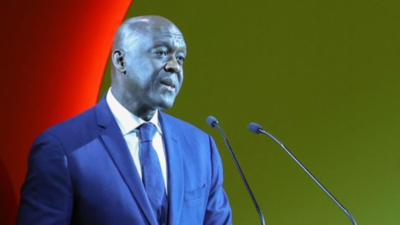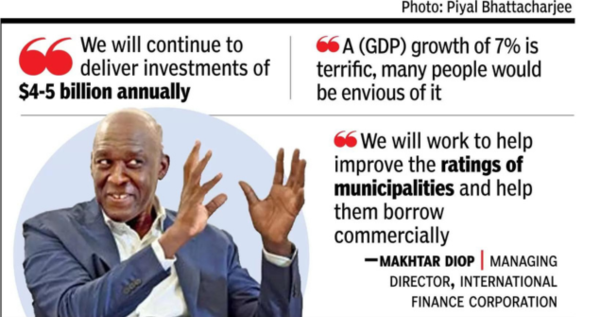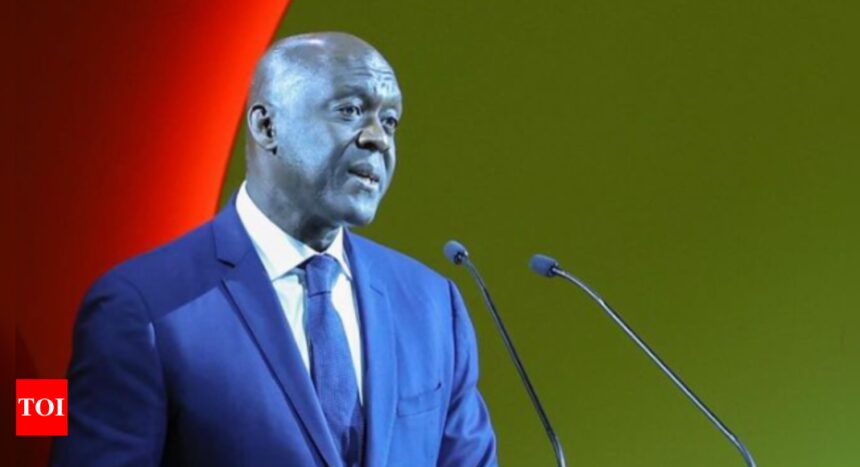
Makhtar Diop, Managing Director of International Finance Corporation (IFC), the private sector lending arm of the World Bank, is looking to expand its focus on India to include the issue of blue tiemodel in the line of green bonds but focused on water, and also help municipalities raise funds. Quote:
Since you last came to India, how do you see progress on the goals you have set for IFC?
India is the largest portfolio. The goal is to double the portfolio. We have tripled. I am happy that we have been able to respond to their needs and build strong relationships not only with the federal government but also with companies and investors. In the past three years, despite the uncertainty, we have doubled our annual commitment to $64 billion this year. In India, we do a lot of business and not just debt. The largest portfolio in equities is in India. While India’s portfolio exposure was $8.7 billion at the end of August, which is 11% of IFC’s total, India’s equity portfolio stood at $3 billion. This is 36% of our portfolio in India, compared to 19% globally. We are mobilizing resources in India due to its strong macroeconomic performance. We want more investment syndicates.
So, if you meet FM Nirmala Sitharaman, what will you tell her about how much investment she will make every year?
We will continue to deliver investments of $4-5 billion annually. I am going to Uttar Pradesh and I want to work with the state. We will be able to help improve the rating of municipalities and help them borrow commercially. The second is to continue working on the energy transition, where we have been successful. Efforts to diversify the production base present a good opportunity for India to enter this space. In the financial sector, we help banks issue green bonds and now we are ready with blue bonds, which are an important part of our offering for water, marine plastics, water management. Water is part of the climate change agenda, which has not been sufficiently discussed and is also related to municipal services. Another thing we want to see is a solution for cooling, which is becoming more important for developing countries. If we are right, it gives a great opportunity and help in the energy transition. Agriculture is another area of focus.

How do you see the macroeconomic situation in India and what are the challenges?
7% growth is so good, people will be envious. There is a common problem of job creation, which exists in every country. It is the challenge of the century. It’s not just the job, it’s the quality of the job. In the same way Ajay (Banga, head of the World Bank) has created a private sector investment laboratory, he is in the process of creating a working council, where practitioners will bring best practices. One of the KPIs of the World Bank group is job creation in the public and private sectors.
The reforms of the World Bank group were marked and agreed upon during India’s G20 presidency. This includes a greater investment role and personal commitment and the IFC is expected to play a part. Is there progress and is there real reform?
When Ajay Banga took over, I worked with him to set up a private sector lab with top investors. Some things come out, they need policy certainty from sovereign governments and the World Bank can help. The second is the guarantee in the developing economy, political and commercial. The third is global uncertainty and maintaining volatility. The fourth element is the size of the planet because some asset managers are $1 billion projects. In India, you have a vision of Viksit Bharat with PLI and a strategy to get investment out of some other countries. To ensure, MIGA has brought everything under one umbrella through standard solutions. We are still working on local currency. The latter is pipeline and syndication. We have a securitization platform, and these assets are pooled. We are working on the IFC 2030 Vision, and we will integrate many elements. For example, we plan to accumulate a lot of equity. When we talk about investing in emerging assets, all these asset managers want debt but often find equity to be risky. So we have to do more equity. We will also use the balance sheet to de-risk some investments. Today, we discuss the possibility of having a first loss fund, which allows you to absorb some of the volatility in the equity market.
Can you shorten the timeline for processing the proposal?
We need to simplify the process, while maintaining integrity. As soon as I arrived three years ago, decision-making was decentralized. We give more responsibility to the region than most things put together in Washington. We increased the threshold for vice presidents and regional directors to decide. We are reducing the number of committees involved. We simplify the decision-making process and ask people to come up with three main points to decide on. This is a culture change because people bring all the decisions to the committee. We also have to take risks. The ratio of non-performing loans has decreased. We also use a lot of technology to save time and use that time to interface with clients. The time taken has dropped by almost half. This is a work in progress, although the team has implemented more than we thought.




